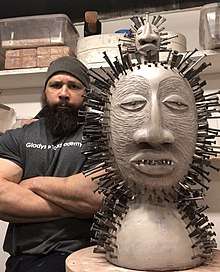Sharif Bey
Sharif Bey (born 1974, Pittsburgh, Pennsylvania, United States) is an American, artist, ceramicist and professor. He produces both functional pottery and ceramic and mixed- media sculpture, using a variety of forms and textures. His body of work reflects his interest in the visual heritage of Africa and Oceania, as well as contemporary African American culture. With his colorful large-scale bead sculptures, Bey explores the cultural and political significance of ornamentation and adornment.[1][2]


Sharif Bey | |
|---|---|
| Born | 1974 (age 45–46) Pittsburgh, Pennsylvania, United States |
| Education | BFA at Slippery Rock University, MFA at University of North Carolina, PhD at Pennsylvania State University |
| Known for | Ceramics |
| Website | https://www.sharifbeyceramics.com |
Education
As a high school student Sharif completed a ceramics apprenticeship at the Manchester Craftsmen's Guild. The Manchester Craftsmen's Guild played a formative role for Bey throughout his teens, giving him a foundation of skills, extensive ceramics-world connections, and exposure to a who’s who of visiting masters – the likes of Ron Nagle, Jun Kaneko, Karen Karnes, Norm Schulman, David Shaner, Judy Moonelis, and Paul Soldner. Later, he earned his BFA in ceramics from Slippery Rock University, his MFA in studio art from the University of North Carolina at Greensboro, and PhD in art education from Pennsylvania State University.[3][4][5][2]
Career
Sharif has taught at numerous universities including Winston Salem State University, Virginia Commonwealth University, and Syracuse University.[5][2] He has held artist residencies at the McColl Center for Art + Innovation, John Michael Kohler Arts Center, and Pittsburgh Glass Center[6]
Art career
His work can be found in the collection of the Smithsonian American Art Museum's Renwick Gallery, Juliet Art Museum, Carnegie Museum of Art, Hickory Museum of Art, John Michael Kohler Arts Center, and the United States Embassies in Indonesia, Sudan, and Uganda.[7][8][9]
His work has been exhibited at:
- Adorned (2020)McColl Center for Art and Innovation[10]
- Pittsburgh Anthology (2019-2020) Carnegie Museums of Pittsburgh [11]
- Disrupting Craft: Renwick Invitational (2018-2019)[12] at the Smithsonian American Art Museum's Renwick Gallery
- Sharif Bey: Dialogues in Clay and Glass (2018)[4] at the Pittsburgh Glass Center
References
- "Open Studio". Craft Council. Retrieved 23 August 2018.
- "Smithsonian American Art Museum". Americanart.si.edu. Retrieved 23 August 2018.
- https://craftcouncil.org/magazine/article/open-studio
- "Pittsburgh Glass Center". Pittsburghglasscenter.org. Retrieved 23 August 2018.
- "Syracuse University". Vpa.syr.edu. Retrieved 23 August 2018.
- https://americanart.si.edu/exhibitions/invitational-2018/sharif-bey
- https://americanart.si.edu/artwork/louie-bones-omega-113524
- https://collection.cmoa.org/objects/f5e0c390-4e98-4ebd-bed3-23f26a47c33c
- https://art.state.gov/personnel/sharif_bey/
- https://mccollcenter.org/portfolio/adorned/
- https://cmoa.org/exhibition/pittsburgh-anthology/
- "Smithsonian American Art Museum". Americanart.si.edu. Retrieved 23 August 2018.